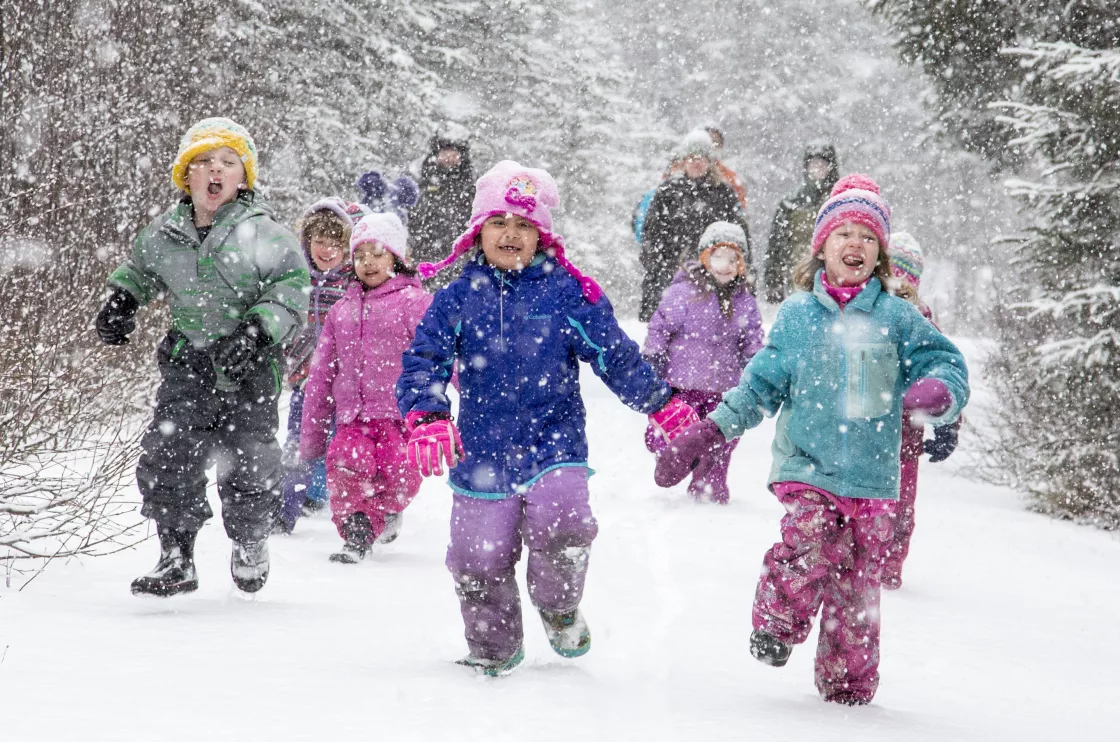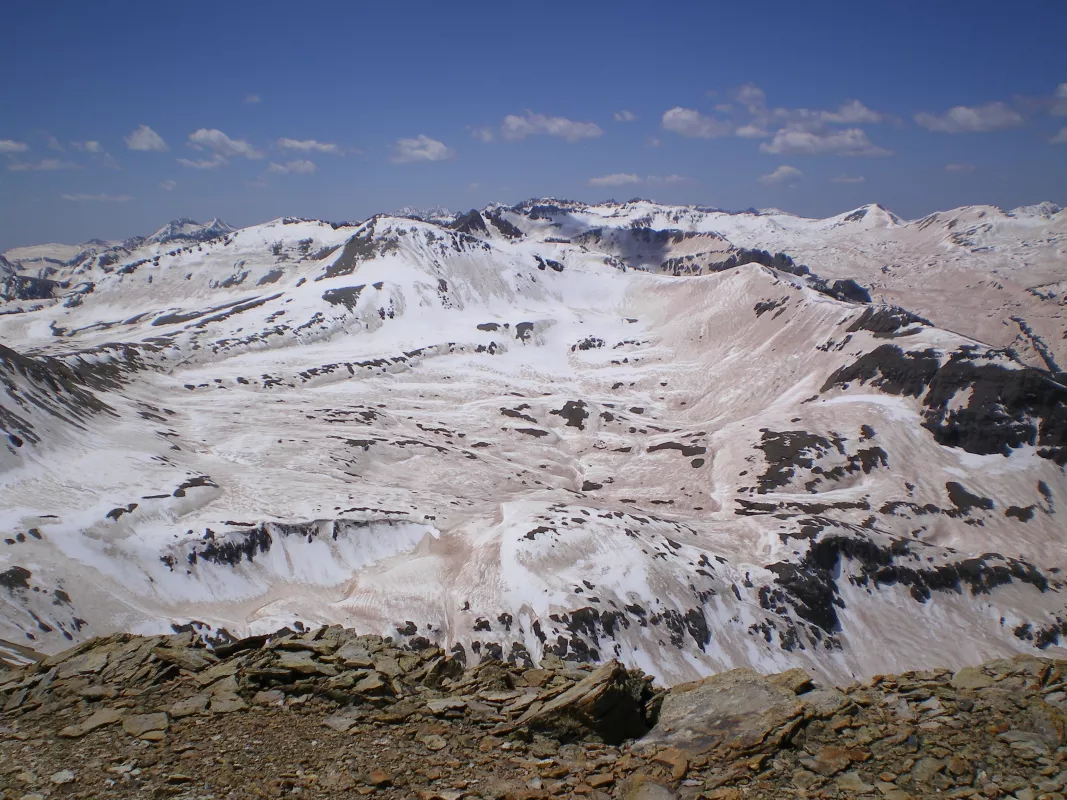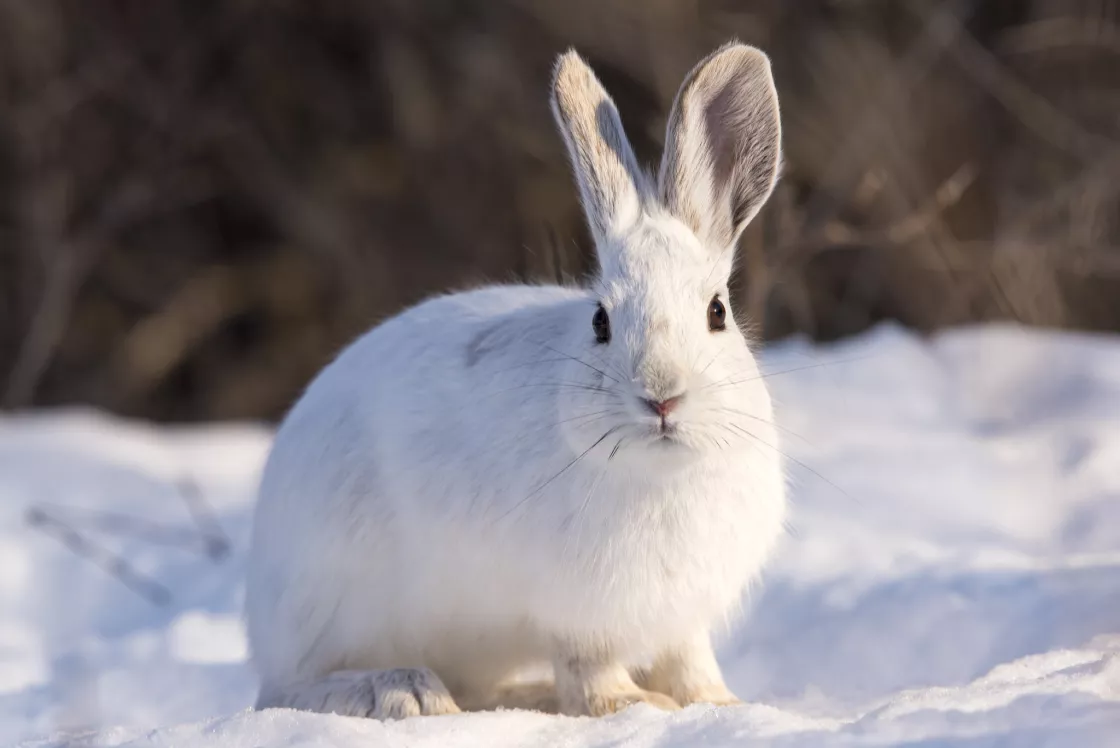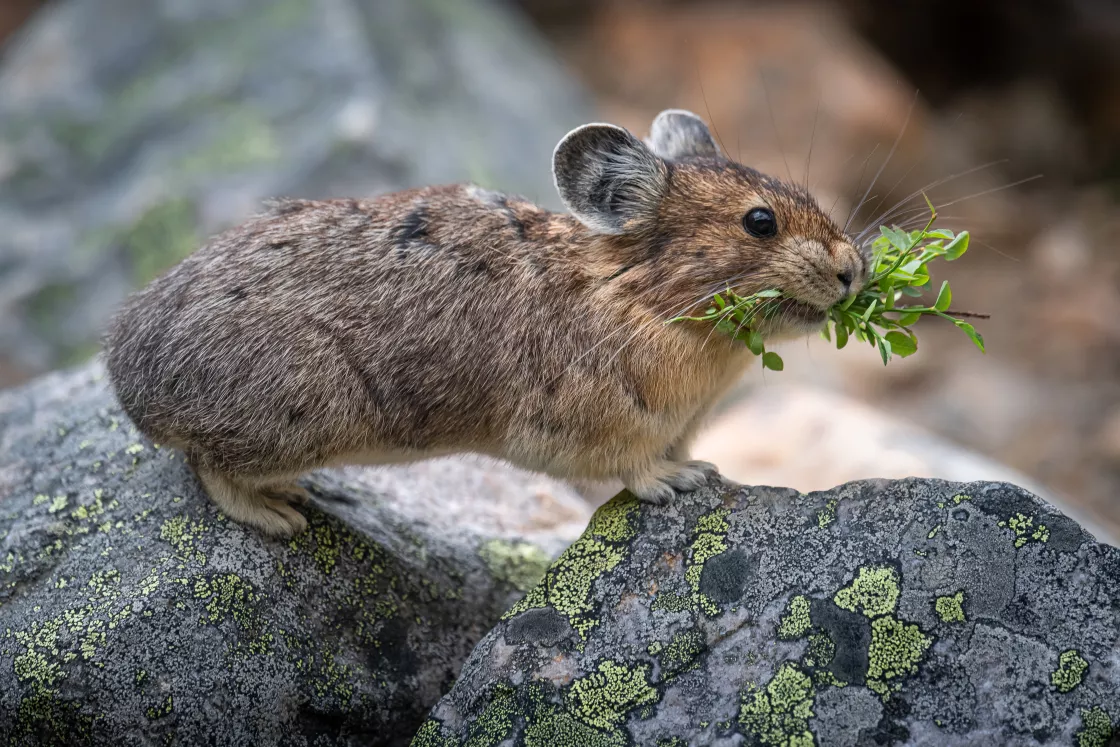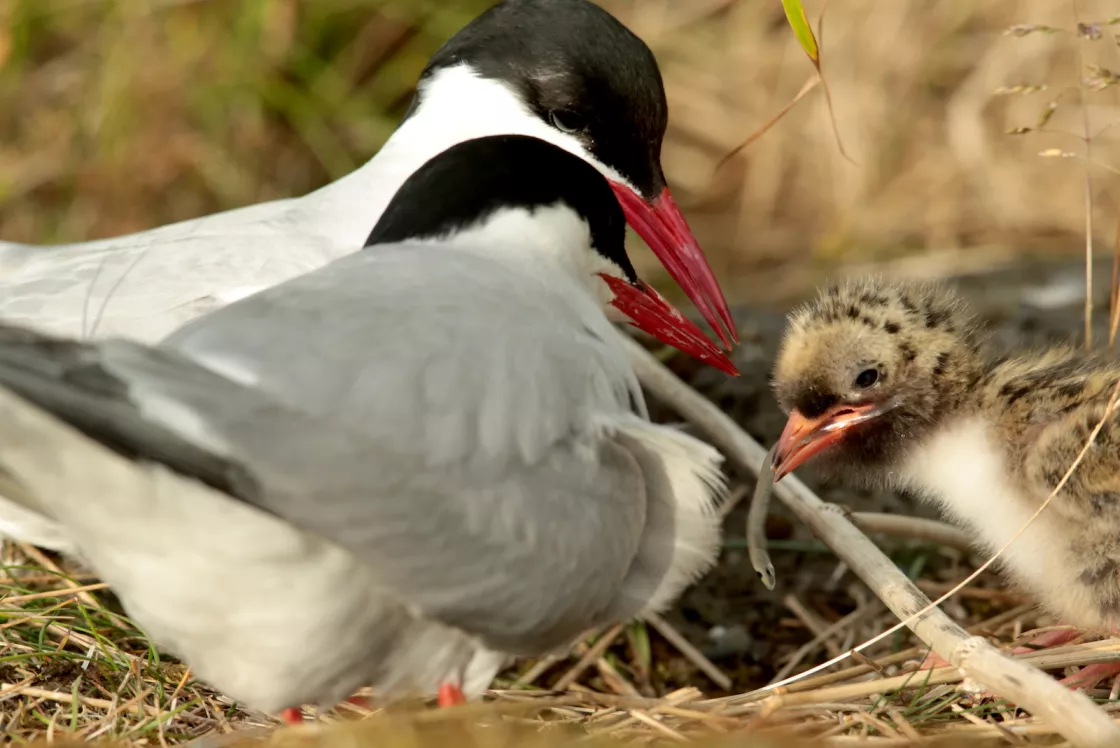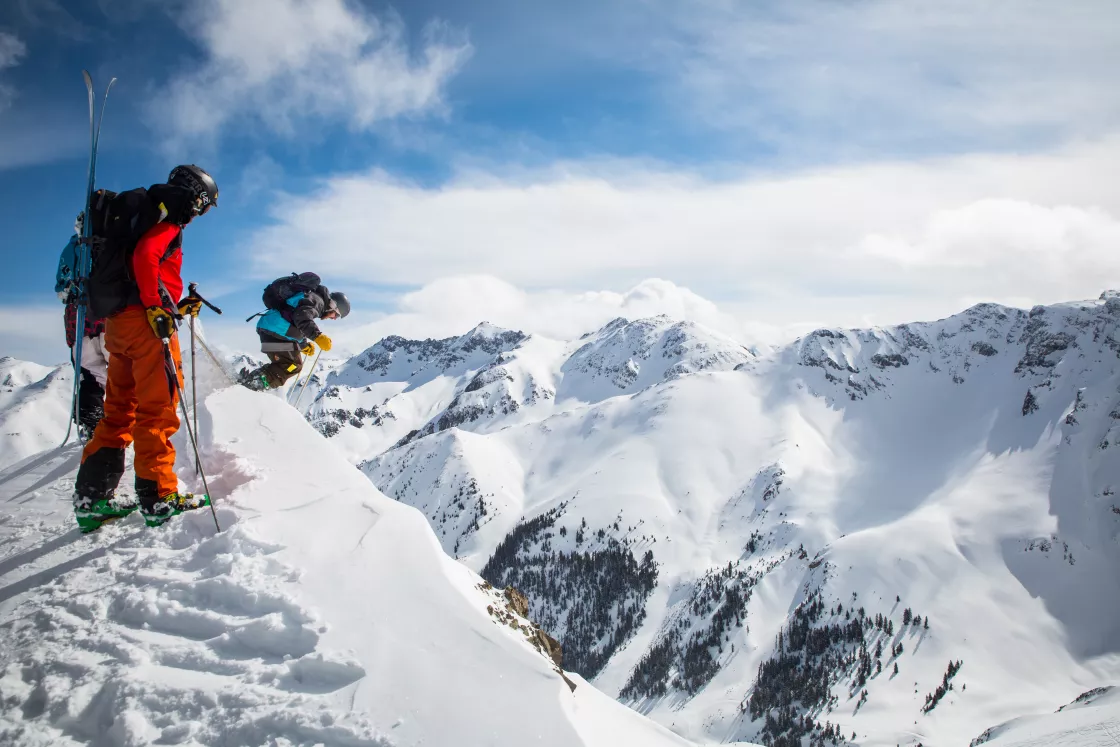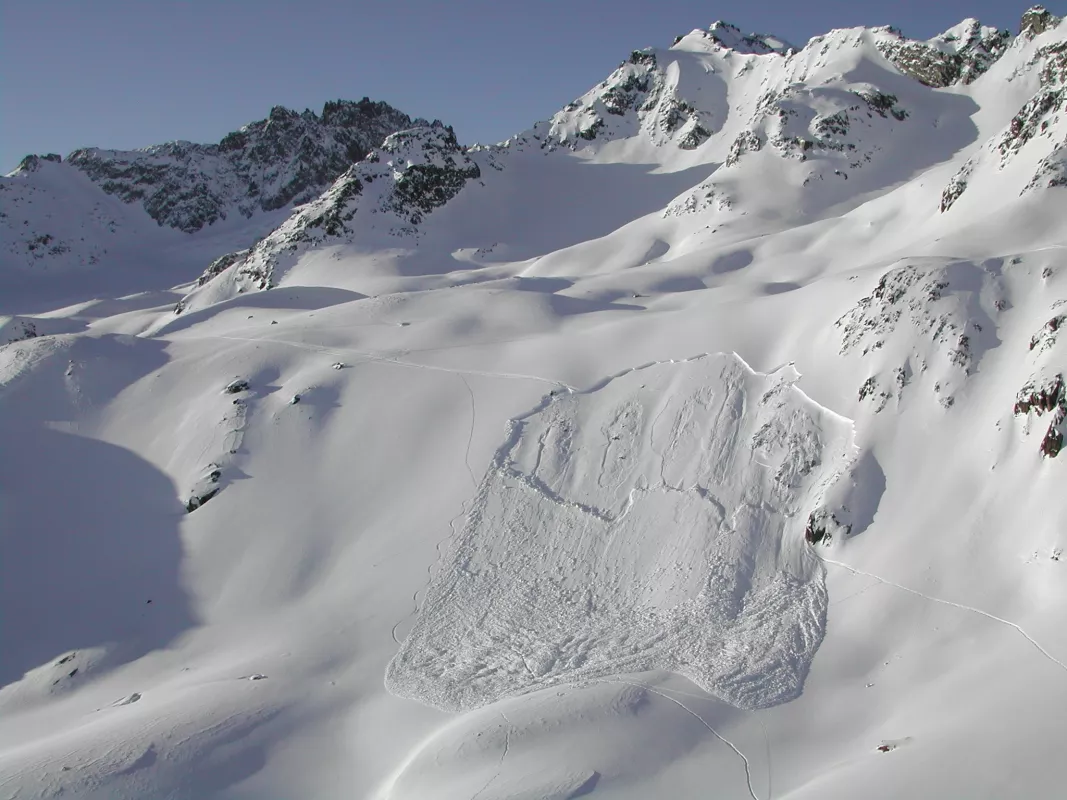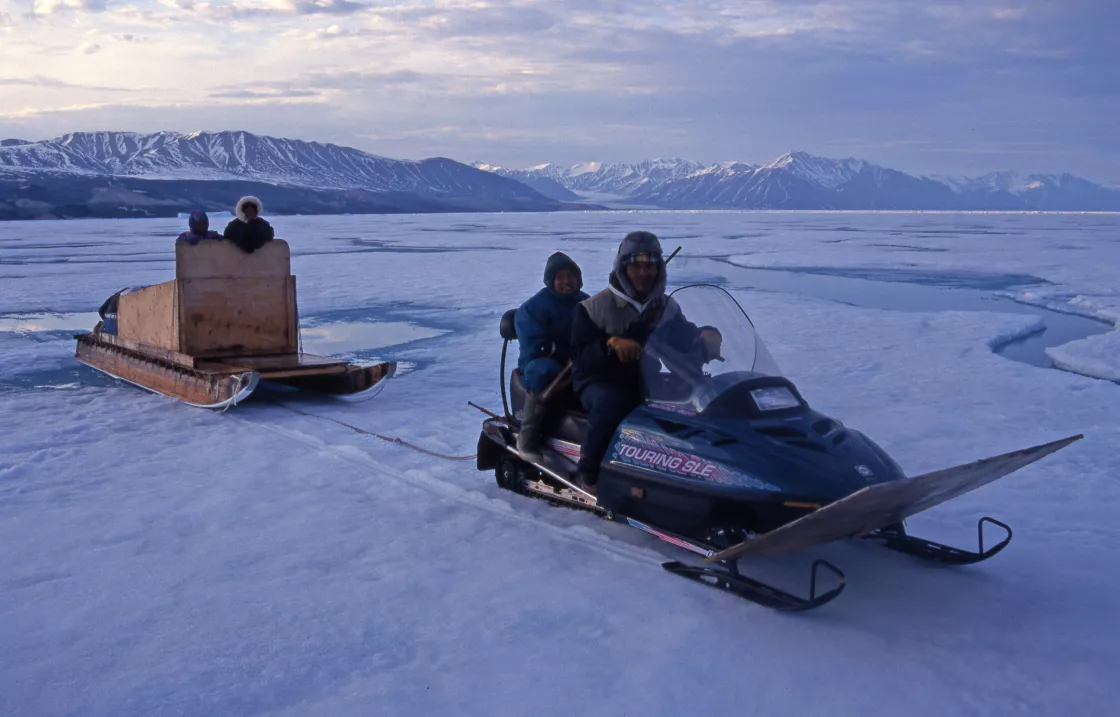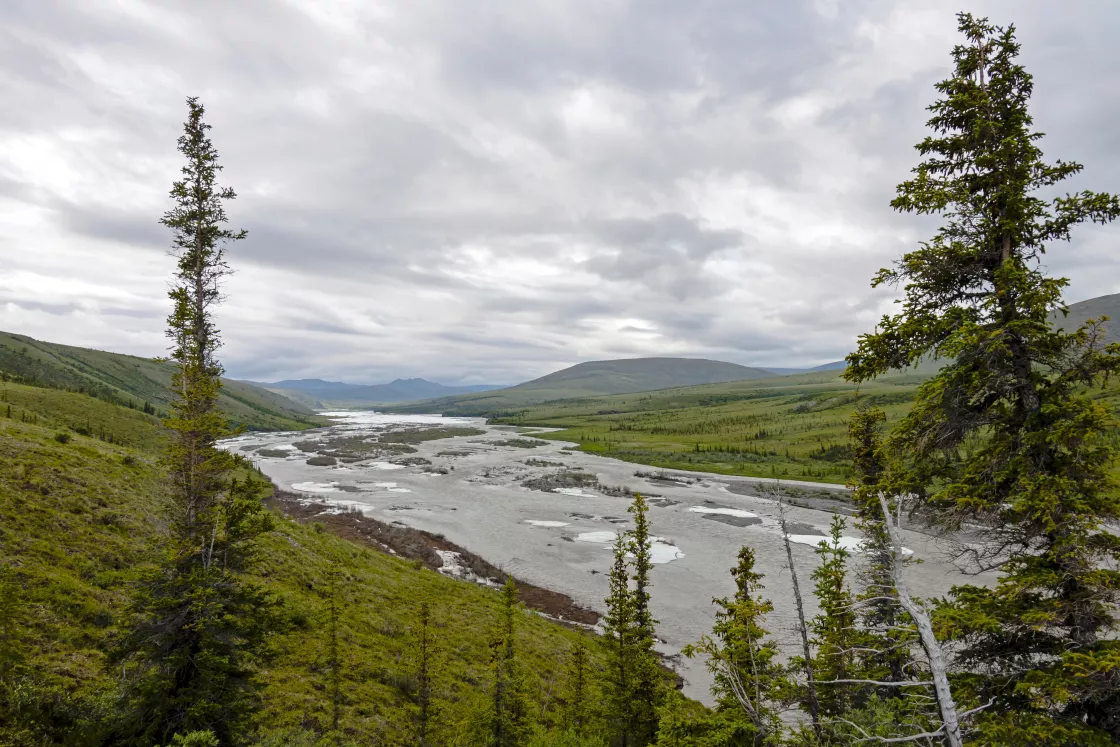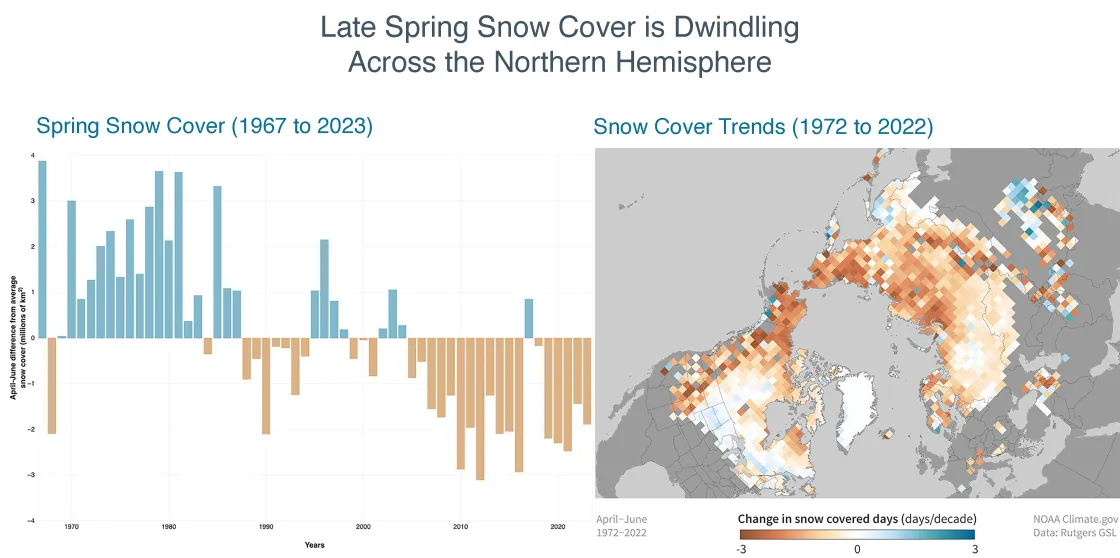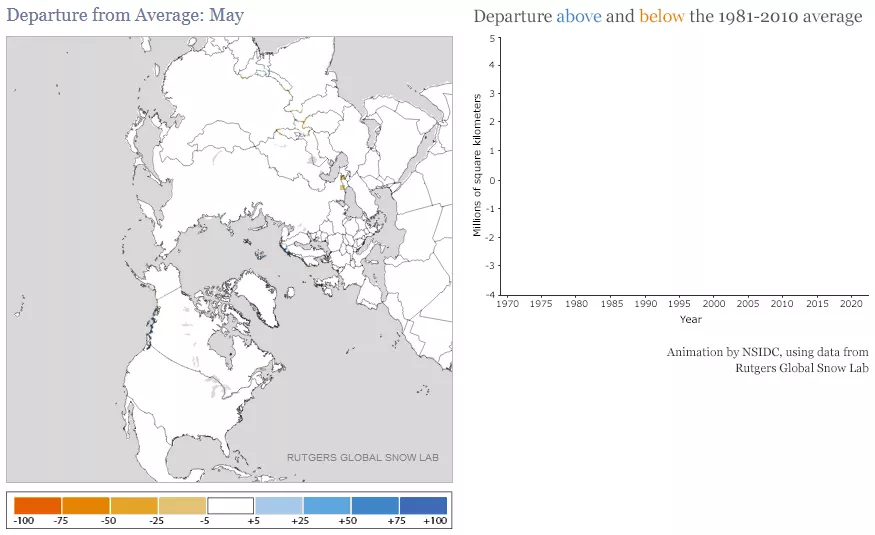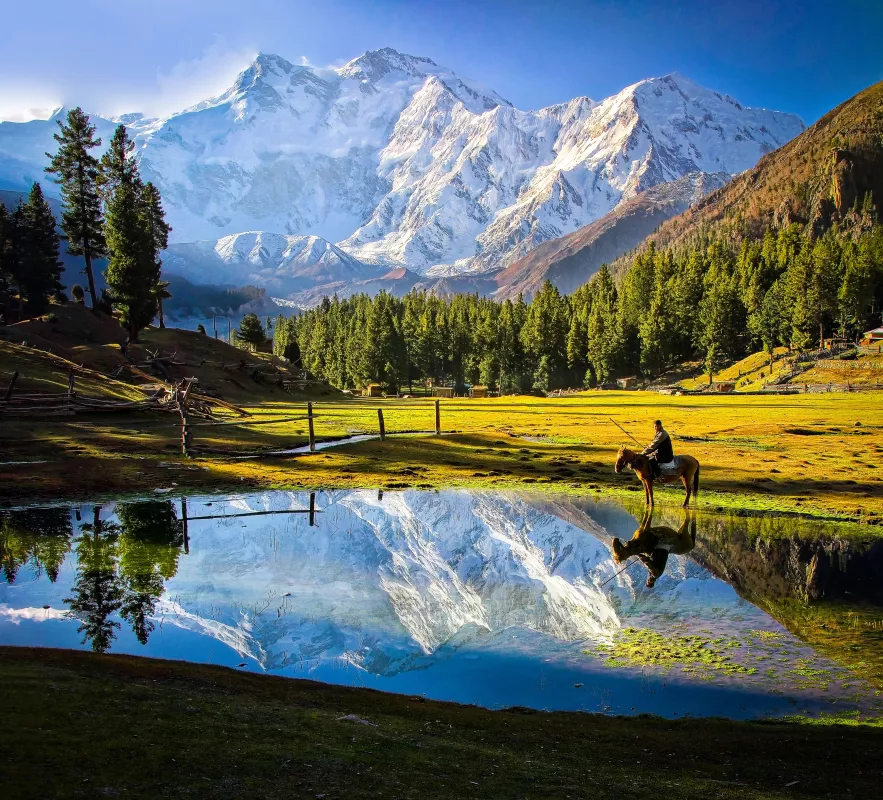Snow
Why it matters
We all associate snowstorms with cold weather, but snow's influence on the weather and climate continues long after the storm ends. Because snow is highly reflective, a vast amount of sunlight that hits the snow is reflected back into space instead of warming the planet. Without snow cover, the ground absorbs about four to six times more of the sun's energy. The presence or absence of snow controls patterns of heating and cooling over Earth's land surface more than any other single land surface feature.
Beyond weather and climate, snow has far-reaching effects on people because of snow’s importance to global food, water, travel hazards, avalanche risks, and infrastructure design. In areas that get a large majority of their water from winter snowpacks, snow droughts could mean lower water availability in the spring and summer. It also means lower generation of hydropower. A study published in 2020 identifies global snow-drought hotspots—eastern Russia, Europe, and the western United States—where snow droughts were longer and more intense in the second half of the 1980 to 2018 period.
For current drought conditions in the United States, go to drought.gov.
Snow also affects wildlife migration, hibernation, and survival. Some animals have evolved to use snow as camouflage. This is most apparent in the Arctic, but with the Arctic warming two to three times the rate of the rest of the planet, animals like the snowshoe hares, which are white during winter and brown during summer, are more easily susceptible to predators because snow is melting earlier while many hares are still wearing their white coats.
Snow is part of Earth’s seasonal cycle. Increasingly common, false starts to spring stretch beyond the Arctic into many other parts of the globe, leaving plants, insects, migratory birds, and even crops vulnerable to subsequent freezes. If frost kills flowers, then there is no nectar or pollen for bees and other pollinators, and no seeds for animals. If spring arrives too early, hibernating animals may miss out on crucial early spring food.
By studying snow, how it forms, where it falls, and how the snowpack changes over time, scientists can better understand how snow affects our planet and our society.
Snow and climate
Seasonal snow is an important part of Earth's climate system. Snow cover helps regulate the temperature of Earth's surface, and once that snow melts, the water helps fill rivers and reservoirs in many regions of the world, especially the western United States. Because of its ability to store water, snow has been referred to as a “reservoir.”
In terms of area, snow cover is the largest single component of the cryosphere, with almost all snow cover located in the Northern Hemisphere. On such a large scale, snow cover helps regulate the exchange of heat between Earth's surface and the atmosphere, or Earth's energy balance. On a smaller scale, variations in snow cover can affect regional weather patterns. For instance, in Europe and Asia, the cooling associated with a heavy snowpack and moist spring soils can shift the arrival of the summer monsoon season and influence how long it lasts.
Reflectance
Snow cover is an important climate change variable because of its influence on energy and moisture budgets. Snow cover has the largest influence during springtime (April to May) in the Northern Hemisphere, when days become longer and the amount of sunshine increases over snow-covered areas.
Snow's high reflectivity helps Earth's energy balance because it reflects solar energy back into space, which helps cool the planet. Snow's albedo, or how much sunlight it reflects back into the atmosphere, is very high, reflecting 80 to 90 percent of the incoming sunlight. However, dirty snow or dust-covered snow can reflect much less. Trees, plants, and soil reflect only 10 to 30 percent of sunlight.
In the Rocky Mountains, as in many mountain ranges worldwide, snowpack is getting dirtier. Winds carry fine sediment particles from arid regions, and dust lofted high enough into the atmosphere can travel hundreds or even thousands of kilometers. This dust can include disturbed soil from construction, farming, and livestock, and fine wildfire debris. Just like wearing black warms a person more than wearing white, a darker surface absorbs more solar energy. The dark topcoat on snow increases the amount of heat absorbed from sunlight, speeding up snowmelt. A 2018 study, involving NSIDC researchers, found that dust, not spring warmth, controls the pace of spring snowmelt that feeds the headwaters of the Colorado River. More dust was correlated with faster spring runoff, regardless of air temperatures, and higher peak flows.
The accelerated melt has multiple consequences:
- Faster snow cover retreat means earlier soil exposure, lower albedo, and more evaporation.
- Faster snowmelt bloats rivers sooner each year, overwhelming river systems earlier.
- Earlier and faster runoff potentially leaves rivers drier in late summer.
As a result, dusty snow can cause water shortages in local Rocky Mountain communities that depend on snowpack.
Insulation and thermal properties
The thermal properties of snow have important consequences for climate as well. Snow acts like an insulating blanket. Beneath just 30 centimeters (1 foot) of snow, the soil, and the organisms within it, are protected from changes in the air temperature above the snow surface. Snow's cold, moist surface influences how much heat and moisture circulate between the ground and the atmosphere. Snow helps insulate the ground below, holding in heat and preventing moisture from evaporating into the atmosphere. Even on top of other frozen material, such as permafrost and river ice or sea ice, snow cover prevents ice from forming as quickly.
When the soil freezes, it locks in gases like carbon and methane, inhibiting chemical exchanges between the ground and air. Frozen soil also inhibits the movement of water within the soil and on the soil surface. Because the soil is frozen, its surface is sealed over and so it absorbs less new liquid water, leading to more surface runoff. In addition, once soil has frozen, snow's insulating qualities can delay melting. Knowing whether soil is frozen, and knowing how soon that soil may thaw, is important in estimating how much water might be available during the spring and summer melt.
Snow and wildlife
It can be difficult for animals to live in places that receive large amounts of snow, such as in the high latitudes and at high elevations. Snowy places tend to receive less sunlight, which decreases temperatures and makes it hard for animals to stay warm. Deep snow can also be difficult to move around in; animals must spend more time and energy walking through it or finding food beneath it.
Adaptations
Some animals have adapted to coexist with the cold. Deer, elk, bison, and other grazing animals use their hooves and muzzles to clear snow away from plants they need to eat to survive. To help retain warmth throughout the winter, they also grow thicker, shaggier coats, which they shed in the spring when the weather becomes warm again.
Other animals, like the snowshoe hare, develop ways to travel on top of deep snow. Snowshoe hares have large hind feet, and they can spread their toes to act like snowshoes, which helps them walk on the surface of deep snow without falling through it. Similarly, the ptarmigan, a bird common to the Rocky Mountains, saves energy by walking on top of the snow with its feather-covered feet.
The pika, another Rocky Mountain native, dries little bundles of hay in the fall, then brings this food under the snow to spend the winter. The Arctic fox, which must deal with the cold, snowy conditions of the Arctic all year, grows thick fur all the way down to the bottoms of its paws. It has a stocky body, short legs, and small ears, all of which conserve body temperature.
During cold periods, frogs, snakes, and other amphibians and reptiles slow their body processes almost to a stop, using up their energy very slowly. Some insects have adapted a life cycle that follows the seasons. They grow and reproduce during the summer months, then die in the fall, leaving their offspring in protective cocoons that will open the following spring.
Hibernation
Deep snow can prevent some animals from finding food, but it also acts like a blanket, insulating the air temperature beneath. Some animals take advantage of snow's insulation. New snow is composed of a high percentage of air trapped among the accumulated snow crystals. Since the air can barely move, heat transfer is minimal. Fresh, uncompacted snow typically contains 90 to 95 percent trapped air.
Some animals cope with the cold season by building in a protective den or burrow and going into a deep, long sleep, a process called hibernation. Bears and groundhogs, for instance, build up fat reserves in the fall, so they can survive hibernating through the snowy winter months, usually not waking again until spring.
Migration
Some animals simply leave snowy, cold regions during the toughest seasons. Arctic terns, for example, spend the Northern Hemisphere summer in the Arctic, and then migrate to Antarctica for the Southern Hemisphere summer, traveling about 39,000 kilometers (24,000 miles) round-trip each year. Migration can also happen over shorter distances: Deer and elk in the Rocky Mountains of the United States tend to migrate down into valleys during the winter.
The timing of spring snowmelt and autumn snowfall also affects migration. North American salmon populations typically migrate downstream when melting ice and snow swell rivers. Many migratory waterbirds take advantage of the 24-hour sunlight and extensive food supplies available during the Arctic summertime. But the timing of birds' breeding and nesting depends on when particular regions in the Arctic become snow free each spring. Some populations nest in Greenland, where snow melts later in the spring season, and there is a smaller window of opportunity for the species migrating there. Arctic areas of Europe, Asia, and Alaska, however, have recently experienced earlier springtime thawing, resulting in more snow-free patches and longer summer seasons for migrating birds.
Snow and people
Over time, people have developed a variety of ways to cope with heavy snowfall, to travel on or through snow, and to stay warm during snowy weather.
Forecasting
Forecasting snow helps commuters and city dwellers prepare for poor weather conditions, and also helps cities plan snow removal efforts. Snow forecasts are better than they used to be, and they continue to improve. However, snow forecasting remains a difficult challenge for meteorologists. One reason is that for many of the more intense snows, the heaviest snow falls in surprisingly narrow bands that occur on a smaller scale than observing networks and forecast zones can see. Also, the extremely small temperature differences that define the boundary line between rain and snow make large differences in snow forecasts.
Drinking water and agriculture
Because many cities rely on snowmelt to replenish reservoirs and water supplies, water managers try to assess the amount of water that a winter's snowpack might produce. To measure snow water equivalent, researchers, and watershed experts use a variety of instruments and methods. The resulting measurements enable water managers to estimate how much water will be available to downstream cities after the spring snowmelt.
Snow and recreation
People living in alpine and Arctic areas have long needed to travel in deep snow, so they invented various forms of equipment that permitted them to glide or walk without sinking into the snowpack. Many of the winter sports people enjoy now, such as snowshoeing and skiing, originated from these practical inventions.
Skiing
Skis originated as a way to distribute a person's weight over a greater surface area. Originally, skis were long, narrow, wooden slats that people bound to their feet. Modern skis may contain wood cores, but are usually made of a variety of materials, including fiberglass, carbon, and Kevlar. Most types of skiing also use poles.
Alpine, or downhill, skiing involves gliding down a slope. Most alpine skiing takes place at mountain resorts with groomed slopes and towlines or lifts to transport skiers to the top of the ski trails. Alpine skis require bindings that keep the skis attached at both the heel and toe of ski boots, but are also designed to release in case of a fall. Alpine skiers generally keep their skis parallel as they travel down a slope.
Cross-country, or Nordic style, skiing doesn't require groomed slopes or resorts, and can be done anywhere, as long as there is enough snow. Cross-country skiers generally use a combination of walking, running, and skating motions to propel themselves across the snow.
For cross-country skiing, boots are generally connected only at the toe to allow more flexibility.
Telemark skiing is a form of downhill skiing, but uses a binding style that attaches only at the toe, which allows skiers to kneel, stagger their skis, and make smooth turns as they travel back and forth down a slope.
Skiers have created their own terminology to describe types of snow, including the terms fluffy snow, powder snow, and sticky snow. The terminology has expanded to include descriptive terms such as champagne powder, corduroy, mashed potatoes, and cement.
Snowshoeing
Snowshoes make traveling over deep snow easier. Snowshoes consist of a hard oblong frame laced with webbing that is designed to distribute weight so that people can walk on top of the snow surface without sinking through. Traditional snowshoes were made of wood with hide webbing, but modern styles employ metal and plastic.
People who live in snowy areas still often use snowshoes, and they are still necessary equipment for forest rangers and others who work in areas that are otherwise inaccessible by vehicles or snowmobiles. Snowshoes also remain popular among recreationalists who like to hike or run in areas with deep snow.
Snowmobiling
Snowmobiles are motorized vehicles specially adapted for traveling over deep snow. Most snowmobiles are propelled by a motorized rear tread, and the driver controls a pair of front skis to steer and maneuver. Although snowmobiles are often necessary to conduct research or rescue operations in snowy areas, many people like to ride snowmobiles recreationally. In addition, many residents and hunters now use snowmobiles as their primary form of transportation across snow and sea ice.
Snow and skin cancer
The sun produces ultraviolet (UV) rays harmful to humans. UV rays are divided into two types: UVA and UVB.
- Ultraviolet A (UVA) rays have a longer wavelength, penetrate the skin deeper, and are associated with skin aging.
- Ultraviolet B (UVB) rays have shorter wavelength, but higher energy level than UVA rays that damage the outmost layers of skin associated with skin burning.
While UVA and UVB rays differ in how they affect the skin, they both benefit and do harm to the body. The three primary health benefits of UV exposure are the production of vitamin D, improvement in mood by boosting serotonin levels, and increased energy.
About 95 percent of the UV rays that reach the ground are UVA rays. The other 5 percent of UV rays are UVB, which are the strongest in summer. However, UVB rays can damage the skin year round, even on cloudy days and especially at high altitudes and on reflective surfaces such as snow or ice.
Snow reflects up to 80 percent of the sun’s UV light, so the rays hit you twice, further increasing your risk of skin cancer and premature aging. UVB rays also directly damage DNA and are the cause of most skin cancers.
Learn more at about skin cancer prevention, early detection, and treatment.
Snow removal
Snowstorms have historically plagued many states, notoriously those located in the Northeast and Midwest. Winter storms occur all over the country, but the “snowbelt,” stretching across the Great Lakes from Minnesota to Maine, receives the brunt of winter storms. Just as the first settlers on New England's shores struggled to survive the brutal snowstorms, so do the inhabitants of today's metropolises. Cities such as Buffalo, New York City, Milwaukee, and Detroit have experienced snowfalls that have stranded their residents in knee-deep or hip-deep snow.
Officially, the National Weather Service defines a blizzard as large amounts of falling or blowing snow with winds in excess of 56 kilometers (35 miles) per hour and visibility of less than 0.40 kilometers (0.25 miles) for more than three hours. German settlers in Iowa originally coined the word blizzard, coming from the word blitzartig, meaning “lightning-like.” European pioneers and settlers were astounded by the severity of the winters. Although accustomed to snow in their home countries, they were newly confronted with driving winds and freezing weather characteristic of snow belt regions.
To learn more about early US settlers and snow, read How did old world settlers combat new world snow? and What is the history of snow removal?
Snowy challenges and new technology
Well after automobile use had become widespread, shopping centers, office parks, and industrial centers saw the need for private snow removal equipment of their own to clear parking lots for their employees and customers. This created a market for smaller, customized equipment, and spurred technological innovations and increasingly specialized functions.
As snow removal efforts progressed, protests against salt commenced, supported both by environmentalists and motorists whose cars were being corroded by years of winter salt use. Environmental experts discovered in the late 1960s that salt use was corroding cars, damaging roadside plant life, polluting water supplies (including drinking water supplies), and killing fish in streams. Cities that continued to use salt invested in improved salt spreaders designed with more efficient spreading gauges.
The snowiest parts of the United States
Snowbelt cities like Buffalo and Syracuse in New York are among the snowiest cities in the United States, but others also receive significant amounts of snowfall. Salt Lake City, Utah, Anchorage, Alaska, and Denver, Colorado, have each received 2.5 meters (8 feet) or more in their record high seasons. These record highs are for cities only; remote mountain areas and smaller towns have received higher snowfall amounts. Paradise Ranger Station in Washington State and Thompson Pass, Alaska, regularly receive more than 12.5 meters (42 feet) of snow each winter. Sites along the Rocky Mountains and Sierra Nevada Mountains also receive between 10 and 20 meters (30 to 70 feet) in a season.
Snow and the environment
To survive in places with snow, living things have evolved some interesting adaptations.
Snow and plants
How do plants survive the icy cold of snow and winter? Unlike animals, which can often leave, hibernate, or otherwise escape a harsh environment, plants cannot. Plants must stay where they are rooted and adapt to the surrounding conditions. One of the most difficult aspects of cold, wintery places is that most water is frozen, and plants cannot take up ice.
Deciduous plants handle the lack of water by shedding their leaves, which tend to evaporate water into the air. During cold winter months, most deciduous plants drop their leaves and go dormant. Evergreen plants keep their foliage, but their leaves and needles have a thick, waxy coating to reduce water loss.
In areas that receive frequent snow and may have cold weather year round, such as in the Arctic, plants have adapted in other ways. Trees may grow close to the ground, or grow in shapes that help them shed heavy snow more easily. Plants may hold on to dead leaves for insulation, or use deep snow like a blanket to protect against the cold. Some evergreens also have a special valve in their cells. This valve automatically seals off individual frozen cells to prevent a chain reaction of freezing.
Just as snow shapes plants, plants sometimes drive snow patterns. Forest vegetation influences how much snow reaches the ground, and how quickly it melts. Snow and certain vegetation spatial patterns reinforce each other. Near the treeline, where forest gives way to tundra, trees may grow in ribbon forests. As the name suggests, these are narrow bands of trees, and in the open spaces between trees, snow often forms drifts. The forest ribbons operate like snow fences. In the summer, deep snow shortens the growing season, impeding seedling establishment and growth. As the summer progresses, however, melting snow drifts enhance soil moisture near the drift, favoring plant growth.
Impact of climate change on snow
Changes in climate can affect how much snow falls and when. From 1967 to 2023, winter snow cover in the Northern Hemisphere had moderate increases, but spring snow cover declined from roughly 31.5 million square kilometers to roughly 28.5 million square kilometers. Spring snow cover matters not only because of the amount of solar energy reflected back into space when the days are longer, but also because spring snowmelt is a viable source of water, especially in the western United States.
In terms of spatial extent, seasonal snow cover is the largest single component of the cryosphere and has an average winter maximum area of 46 million square kilometers (17.8 million square miles), about 98 percent of which is located in the Northern Hemisphere.
In the Northern Hemisphere spring (April through June), snow cover lingers mainly over the Arctic, where snow blankets the ground for up to nine months a year. The timing of springtime snow melt is particularly important in terms of spring river runoff, permafrost thaw, and the length of the growing season. Springtime snow cover extent has historically fluctuated over three- or four-year cycles in a La Niña/El Niño Oscillation, but other atmospheric-oceanic oscillations have different periods. Snow cover has high annual variability, but observations have shown trends in long-term snow extent declines. For instance, higher air temperatures in Alaska have caused the snow to melt earlier each spring, lengthening the snow-free summer season.
Scientists have developed ways to continuously measure how much snow covers the planet. Over the long term, this record of snow cover will help scientists understand how climate change is impacting snow. Scientists are modeling how Earth's climate will change over the next 100 years, and the results suggest that snow will cover less of the planet, particularly over Europe, eastern Asia, and the western United States. In the long term, this information can help water managers assess water infrastructure, reuse, and efficiency.
A not-so- “positive feedback”
Where snow cover is disappearing earlier in the spring, the large amounts of energy that would have melted the snow can now directly warm the soil. With decreased snow cover, the Northern Hemisphere reflects less energy into space, absorbs more solar radiation, adding heat to the system and melting more snow. This is the classic temperature-albedo feedback mechanism; it is a “positive feedback” because it reinforces itself. Surface temperature is highly dependent on the presence or absence of snow cover, and temperature trends have been linked to changes in snow cover.
Is snowfall declining?
Unlike Arctic sea ice, which shows a clear downward trend in sea ice extent, snow has much more variability from one season to the next. Long-term Northern Hemisphere snow trends are somewhat mixed, but overall show decreases in metrics such as snow cover extent, snow water equivalent (the amount of water in snow), and snow depth, especially in spring. A 2016 study, titled Trends and extremes in Northern Hemisphere snow characteristics, identifies a negative trend in maximum seasonal snow depth between the 1960-1961 winter and the 2014-2015 winter. The trend is especially strong in North America, and apparent to a lesser extent in European stations discussed in the study. The authors report, “These results are mostly, but not fully, consistent with simple hypotheses for the effects of global warming on snow characteristics.”
Snow totals and snow extents measured in 2015 and 2016 fit the larger pattern of declining trends, based on a study analyzing the 2015 to 2016 US snow report. That winter, most parts of the contiguous United States showed below-average seasonal totals. The one exception was the mid-Atlantic, which received most of its snow in a single blizzard in late January 2016. Throughout the Northern Hemisphere, 2016 snow cover extent ranked twelfth lowest out of the 47-year average.
The dirt on snow
Declining snow extents are consistent with expectations for a warming climate, but another factor may also be at work. Aerosols such as dust and soot accelerate snowmelt by reducing the amount of energy reflected off the surface. Darker surfaces absorb more solar energy, speeding up snowmelt.
In Colorado’s San Juan Mountains, disturbed desert dust on the snow surface has affected seasonal snowpack duration. Precipitation was near average on the Colorado Plateau in 2005; the following year, the plateau experienced severe drought, and the resulting dust deposition shortened the snow-cover duration by 18 to 35 days based on a 2007 study. When dust or soot covers snow, the dark topcoat absorbs more heat from sunlight.
A 2015 study, entitled Regional variability in dust-on-snow processes and impacts in the Upper Colorado River Basin, shows that dust loading on the Colorado River Basin snowpack has increased fivefold since the mid-nineteenth century. Land use and abuse, new dirt roadways, infrastructure construction, and agricultural practices have largely driven the increase of dust in the region. By accelerating snowmelt, dust deposition has a significant effect on river runoff and water availability for seven US states and parts of Mexico, which depend on water from the Colorado River.
A 2018 study, involving NSIDC researchers, found that dust, not spring warmth, controls the pace of spring snowmelt that feeds the headwaters of the Colorado River. Contrary to conventional wisdom, the amount of dust on the mountain snowpack controls how fast the Colorado Basin’s rivers rise in the spring regardless of air temperature, with more dust correlated with faster spring runoff and higher peak flows.
The accelerated melt has multiple consequences:
- Faster snow-cover retreat means earlier soil exposure, lower albedo, and more evaporation.
- Faster snowmelt bloats rivers sooner each year, overwhelming river systems earlier.
- Earlier and faster runoff potentially leaves rivers drier in late summer.
As a result, dusty snow can cause water shortages in local Rocky Mountain communities that depend on snowpack.
When snow turns to rain
Warm periods of spring-like weather during winter may also cause rainfall instead of snowfall, or force unusual melting during a normally cold season. Warmer spring weather in Alaska and in the Canadian Arctic areas has caused more frequent melting and refreezing of snow, as well as more frequent rainfall. This extra water may seem beneficial for vegetation, and consequently for grazing animals. But nighttime temperatures during the Arctic springtime are still low enough to freeze the rain and melted snow, which either seals the ground beneath into a sheet of ice or tops the snow with an impenetrable ice crust. Musk oxen, caribou, and reindeer evolved to sweep snow off to graze, but they cannot break through thick ice. Often unable to travel and eat, they die by the tens of thousands. The consequences ripple to the communities that depend on these animals for food and/or economic security.
Learn more about the Arctic Rain on Snow Study (AROSS) at NSIDC.
When snow dries up
Changes in the amount of snow covering the ground, and changes in how the snow melts in the spring, will affect the water supplies that people use for things like farming and making electricity. Glaciers and snow cover are especially vulnerable to higher temperatures, particularly in lower alpine elevations. Both glaciers and snowpack lock in fresh water, releasing it with warmer weather, thus acting as a reserve in times of drought.
Snow and glaciers are intricately connected, since glaciers depend on snow for their stability. When snowfall decreases, glaciers shrink in size. The consequences can be quite severe for certain parts of the world.
Retreating glaciers and decreasing snowpack are prompting concerns about dwindling water supplies throughout India and southwest Asia. During Pakistan’s summers, 75 percent of the country’s stored water comes from glaciers. Changes to this supply would impact almost 200 million people, affecting drinking water availability, agriculture, hydropower, tourism, and recreation in the region. A clear example of a glacier in retreat and its consequences is the glacier on Miragram Mountain in Pakistan. Villagers living at the foot of this mountain in the Chitral Valley have depended on the glacier for drinking water for generations. Diminished snowfall, higher temperatures, and heavier summer rainstorms are eating away at this glacier. The Chitral Valley is about 2,600 square kilometers (1,000 square miles), or about the size of the state of Rhode Island or the country of Luxembourg. When its population boomed six-fold to 600,000 from 1950 to 2016, the unreliable electrical supply forced many to seek other ways to refrigerate their food, turning to opportunists who sold chunks of the shrinking snowpack in shopping bags.
Ski resorts located in temperate mountain ranges, like those located in western North America, New Zealand, and the European Alps, already experience winter temperatures that are only slightly below freezing, and even a small increase in air temperature may shorten the ski season, or cause complete ski area closures. In fact, Bolivia's only ski resort, located on Chacaltaya Glacier, closed in 2009 after the glacier retreated for two decades, then disappeared altogether. The ski resort in Whistler, British Columbia spans a significant elevation difference, and while the summit is likely to remain snowy during ski season, conditions at the base are increasingly likely to be rainy. In addition to air temperature, humidity can be an important climate factor for ski-resort snow. For example, snow making is more feasible at ski resorts in drier climates (such as Colorado) than at ski resorts in wetter climates (such as the Pacific Northwest), especially when temperatures are near the freezing point.
